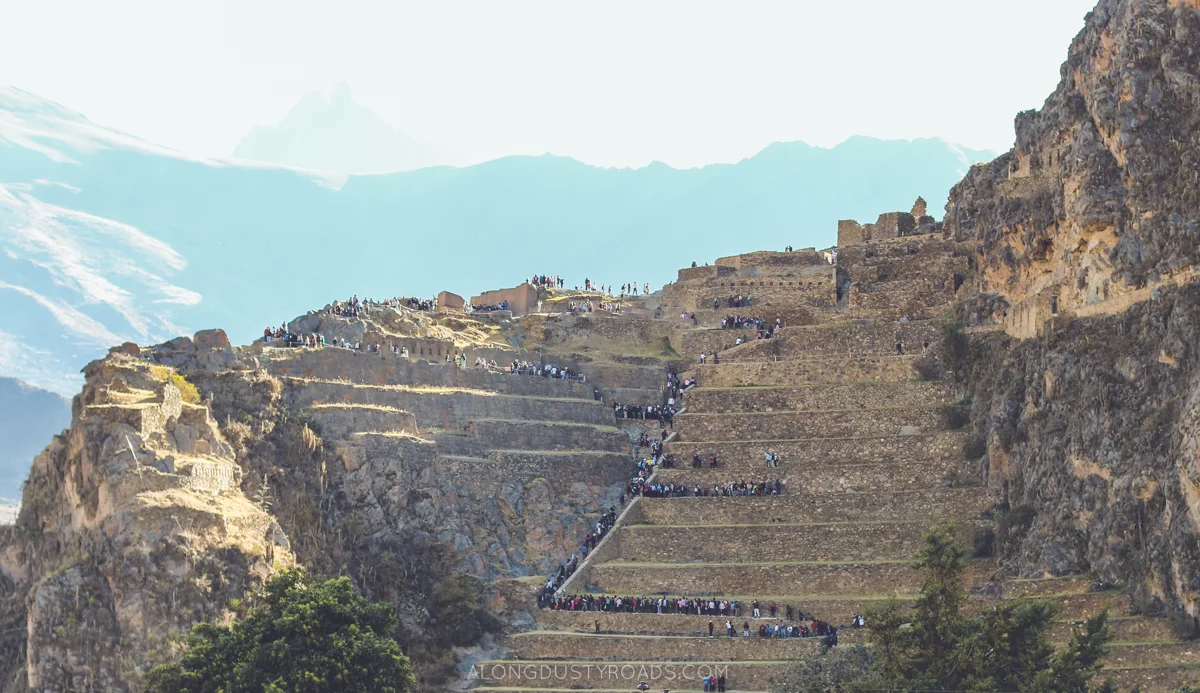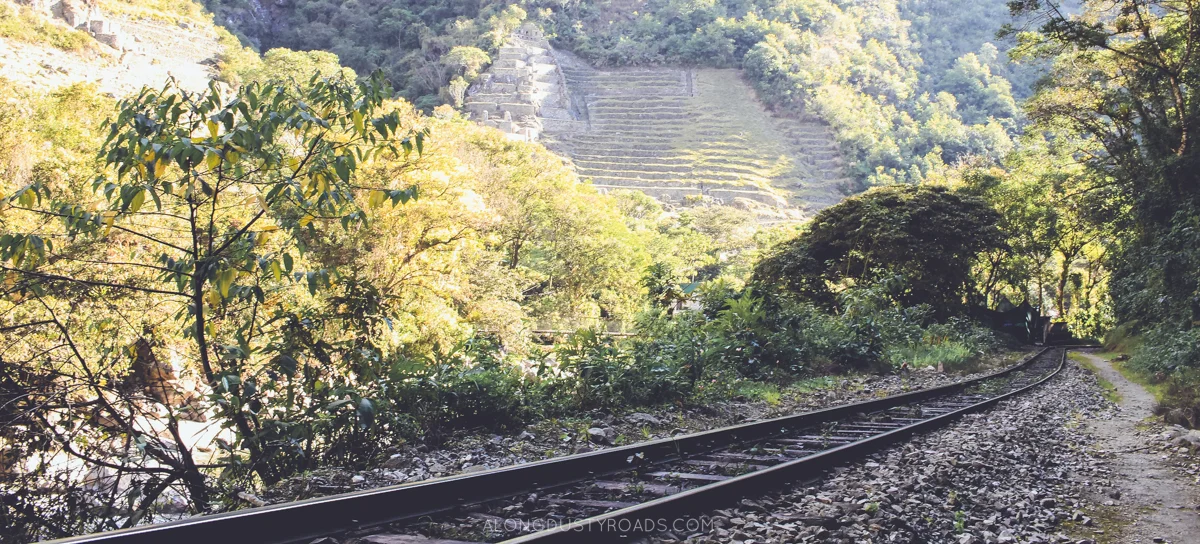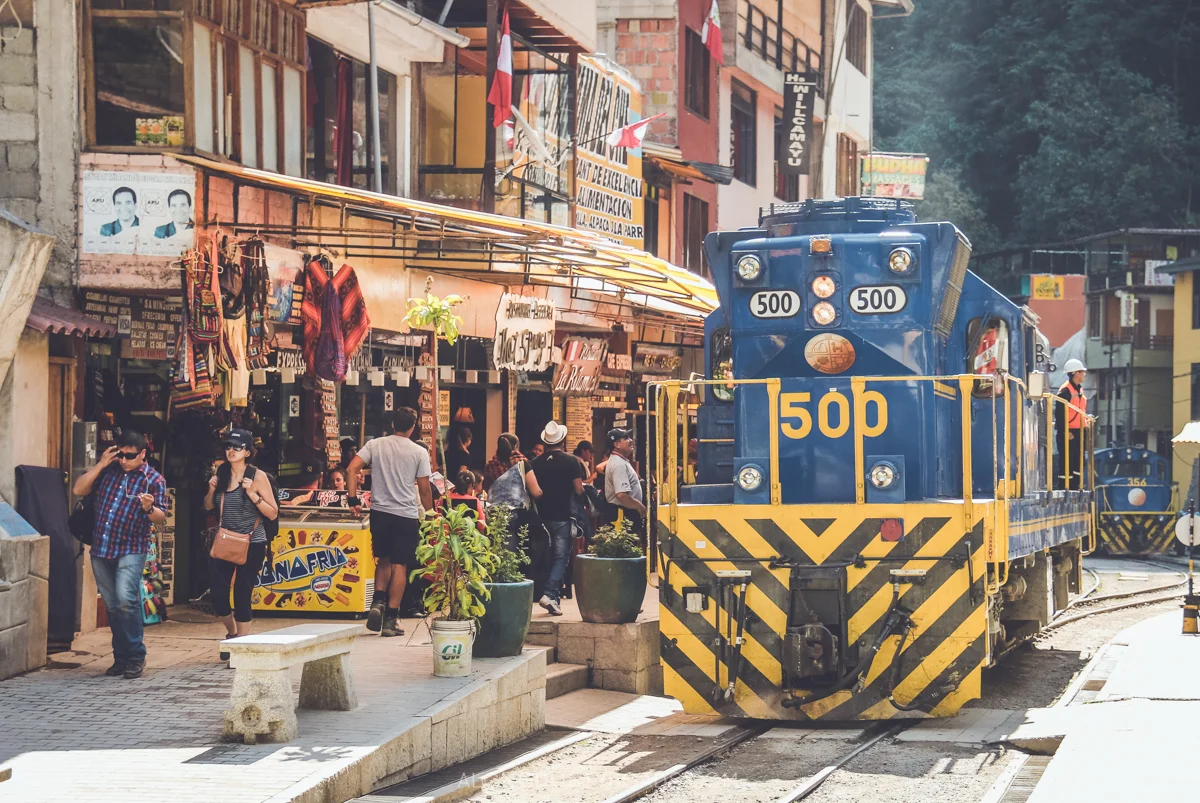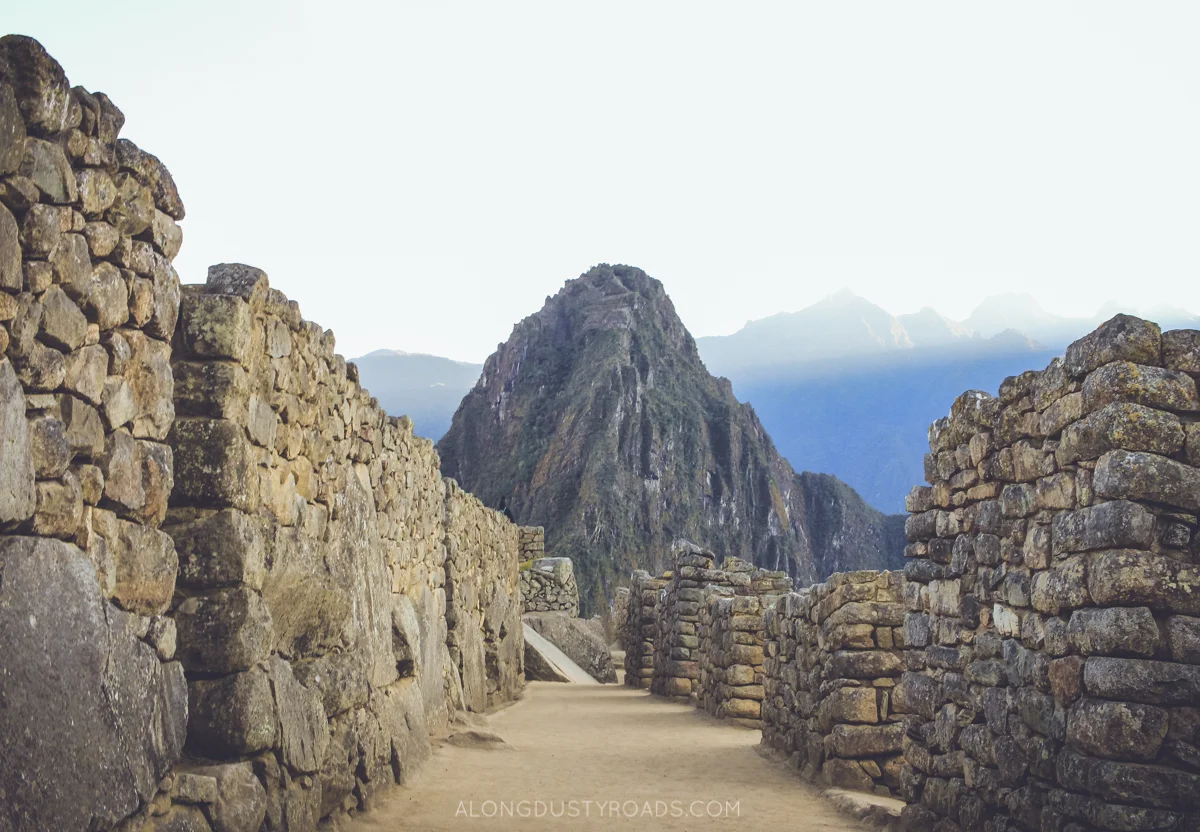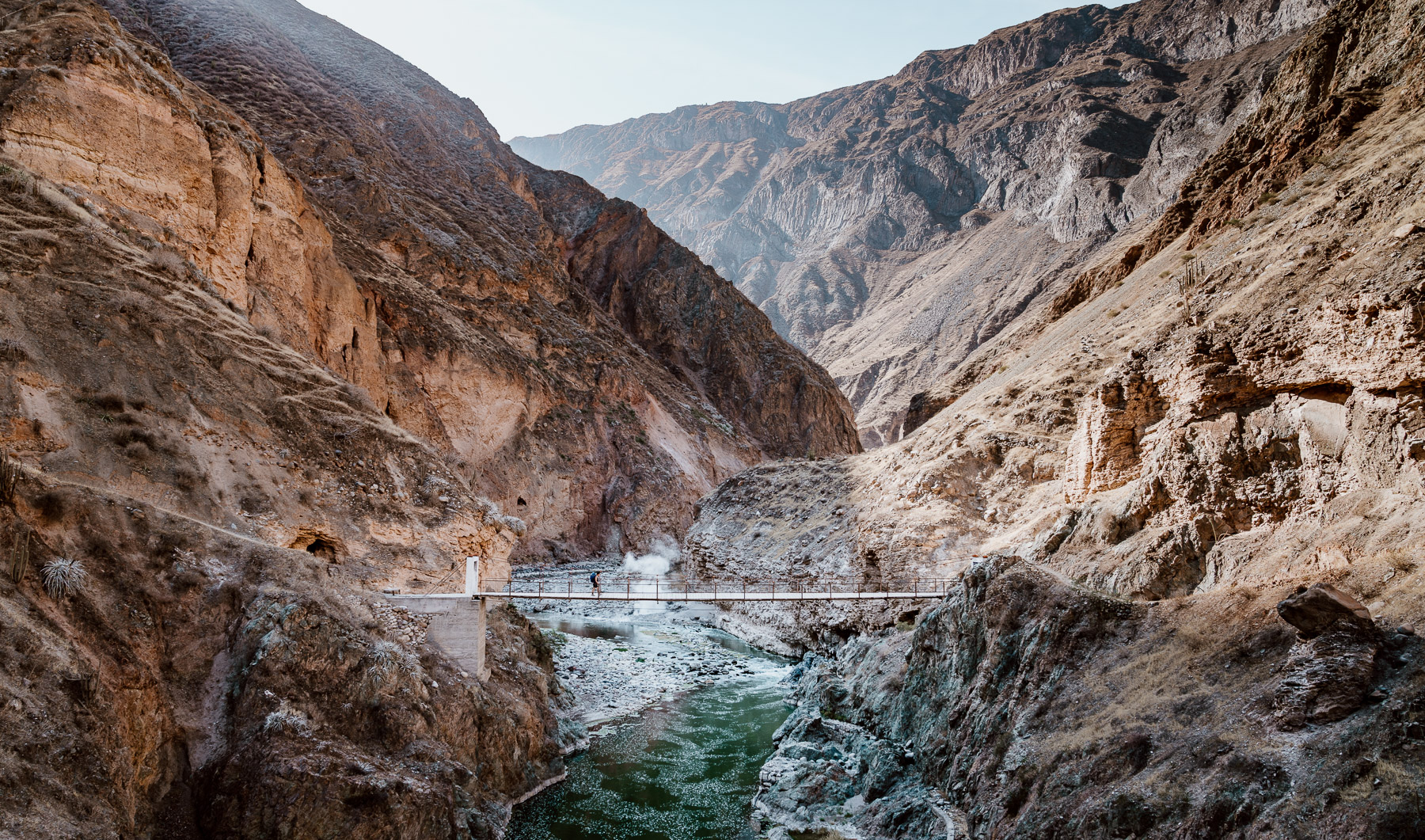Want to know how to walk to Machu Picchu beside the train tracks from Ollantaytambo, the very cheapest way to hike to Machu Picchu, or just a more adventurous way to get there?
This is our experience of walking the route from Ollantaytambo to Machu Picchu in 2016
(Article updated March 2019)
Machu Picchu, for some the jewel in the South American traveller crown, isn't cheap.
A number of backpackers we met in Peru were bemoaning the fact that they'd been forced to part with a big chunk of their hard-saved travel funds to see the hidden Inca citadel, even though they felt they had done everything as economically as possible.
The cheapest entry ticket is £35 / $45 / €40 (updated March 2019). A bus monopoly charging $12/£8 is the only vehicular option to the site entrance from Aguas Calientes. The round trip train-ride from Ollantaytambo costs at least £90 / $120 / €106 each, if you're lucky.
Tip | There were wholesale changes to the ticket system for Machu Picchu in 2019 - read this overview before buying yours.
Already, in doing the 'traditional route' in the cheapest manner possible, you're close to spending £140 / $180 / €160 per person without factoring in your accommodation, food and other transport for the two to three day period it takes to travel in and out. If your eyes are already watering at this, then forget about doing the multiday Inca Trail trek (we actually returned to Peru in late 2018 and did the Inca Trail - read about it here).
Why does it cost so much to get to Machu Picchu?
Firstly, due to its status as one of the world's most popular and iconic travel destinations, it attracts travellers and tourists of every hue and budget. The people in charge can therefore charge whatever they like; people are guaranteed to keep on paying it in their thousands each and every day. The best example of this is the monopoly on the buses resulting in $12 for a foreigner or $8 for a local to ride the fifteen minutes up to Machu Picchu's entrance - for our money the most expensive bus route in South America per kilometre.
Secondly, aside from the tourist train, there are no alternative transport options in/out of Aguas Calientes. With no road out of town whatsoever, the train companies have you over a barrel. Locals do thankfully have access to a heavily subsidised train fare - it costs them $1 for a journey which costs at least $70 for a foreigner - but it is nigh-on impossible for any backpacker to access this price.
So, is there a solution for those on a tight budget trying to make it to Machu Picchu? Yes. In fact there are two.
the cheapest way to reach aguas calientes
What we're about to tell you may sound crazy but, we did promise to show you a way to get to Machu Picchu for $1! Ok, technically, $44 as the entry charge to the site has to be paid.
This option isn't for the unfit or the faint-hearted. It’s also no for idiots. It will involve up to ten hours of solid walking, some preparation, and taking a few risks.
Ready?
The cheapest way is to walk 28 kilometres alongside the rail tracks from Ollantaytambo to Aguas Calientes, the town at the foot of Machu Picchu, where you'll then need to spend the night.
We did it and it was one hell of a travel experience - here’s the route and what you need to know.
make your way from cusco to ollantaytambo
We recommend starting this route after spending a day or two enjoying Ollantaytambo but, understandably, a number of you reading this will be starting out from Cusco. So, to reach Ollantaytambo from there, walk or take a taxi for the short ride to Calle Pavitos (just off Avenida Grau) where you'll find collectivos (10 soles / $3 /£2.3 per person, 2 hours). They leave when full - if there’s a group of you, you may prefer to take one of the group taxis from the same street which charge 12 soles per person for the same journey.
Read Next | If you’re in Cusco just now, then read our guide on the best things to do in the city.
The photogenic centuries old streets of little Ollanta (as it's known to the locals), which unfortunately from late morning to late afternoon are overrun and ruined by bus loads of tour groups, are well worth a wander. The stone houses, cobbled pathways and drainage systems all date from the days of the Inca and retain a lot of the original features, making it a unique historical spot. It's also a sensible jump-off point to visit the nearby Moray circles - read our guide to Ollantaytambo here.
On this cheap alternative route to Machu Picchu, you're going to need spend at least one night in Ollanta, so why not make the most of it and try to arrive early from Cusco. Take the time to explore the streets and ruins and perhaps grab lunch in the plaza at the lovely El Rincon cafe. However, for undertaking the rail track walk, you must keep a few hours reserved for essential preparations.
pre-trip preparations
First up, visit the locals market to stock up on fruit, snacks and water for the long hike. Our go-to hiking menu is to breakfast porridge with milk, raisins and banana which we make in our room and store in our tupperware. For lunch, a decent option which you can prepare in any hostel without a kitchen is tuna mayo sandwiches accompanied by crisps.
Next up, work out exactly what you're going to need for the two or three days you're going to spend in and around Aguas Calientes. This is all going to be on your back whilst walking along the tracks, so try to pack light. Alongside food supplies for the walk, the minimum you'll require is hiking gear, a change of clothes, first aid kit, some toiletries, cash and documents and any pieces of technology (don't forget the chargers!)
Your final priority is going to be working out where to store your luggage. If you've opted to spend the night in a nicer hostel with lockers or a secure room available, then that would be your best bet. The accommodation we were staying in didn't provide that so we enquired around town.
There were a handful of options and we opted for a restaurant near the plaza which advertised luggage storage (it's on the right hand side just before the bridge where you turn left to the train station); they kept our big rucksacks in a locked room for 2.5 soles per bag per day and gave us a receipt as evidence. Another option is 'Green Apple', a small cafe next to the train station.
Lastly, be sure to have an early, booze-free night as you're going to need your energy the following day.
an early collectivo to kilometre 82
As the 28kms walk is going to take a minimum of seven to eight hours, you have to set off early; we had packed the previous evening and were out of our hostel by 6 a.m.
Next to the main plaza, opposite the entrance to the market, you'll find colectivos to bring you to 'kilómetro ochenta y dos' or Kilometre 82.
The service starts between 5.30 - 6 a.m., travel time is around 30 minutes and the cost is 3 soles / $1 /£0.7 per person.
dodging the train guards
You'll exit the collectivo just above the train tracks. This was the part of the walk we were most concerned about - some accounts said that the train guards would stop anyone passing through as, technically, walking on or along the tracks isn't permitted (perfectly understandable!)
However, whilst in Ollantaytambo, we were lucky enough to chat with a local who had done this route numerous times on his own and with friends. He advised on how to do it safely and told us that, in the event somebody stops you and isn't susceptible to your charms, then you need to outline that you missed joining your Inca Trail group and the guide advised you to walk this route to meet them at a bridge further down the line. Andrew wasn't terribly comfortable with doing this - what would we do if it all went wrong? - and thankfully we found a more viable alternative.
After telling the colectivo driver our plans, he indicated that there was actually a path we could take for a few kms which would bypass the train supervisor, thereby allowing us to descend to the tracks further along. We verified this with a local lady after we got off the bus and, with fingers crossed, set off.
The little track is actually pretty easy to find from where the colectivo drops you off (if unsure just ask a local if you're going in the right direction). It will take you past a couple of shops and houses before leading you into an open grassy area. Below you on your left-hand side, you'll see the tracks so, as a guide, just keep heading in the same direction as those.
Eventually, you'll see a path down to your left which will allow you to safely join the tracks.
Tip | See the comments for recent experiences of travellers who have done this route. Security has tightened in a number of ways and it’s absolutely not guaranteed that you can access the trail.
walking alongside the tracks
Now, we're aware of how foolish and downright dangerous it can be to walk on and alongside train tracks; it's not something we'd usually even do, let alone advocate. So, let us address a few issues:
1. You can walk the entire stretch without having to step on the tracks; there is adequate space on each side of the railway line for you to walk.
2. This is an active railway line, i.e. trains going to/from Aguas Calientes still use it on a daily basis. Check the train schedule the night before so you are aware of roughly how many trains are going to pass each way. These trains are however relatively slow-moving and, on each occasion, we heard them coming (sometimes signalled by their horn) and were given adequate time to move safely out of the way.
3. There are tunnels. From Ollantaytambo to Aguas Calientes, we passed through about seven. Thankfully, each of them was short enough so you could see the literal light at the end of the tunnel and be aware if the noisy trains were on their way. Nevertheless, the tunnels should always be approached with a high level of caution.
4. Was it safe? We encountered only a handful of people along the way. All nodded hello and gave us a smile. We didn't feel unsafe on the hike but, as with everything when you travel, it would be best to do this walk in a group of at least two.
5. There are a number of stray/territorial dogs along the train tracks and whilst they'll probably cause most people absolutely no problems, this is where we unfortunately have to admit that Emily did in fact get bit. You can read the full story here but suffice to say it was a bit of a nightmare. But not an experience that would stop us making the same trip again. For your own hike, just be aware that there are dogs around and pick up rocks as soon as you see one - and don't be afraid to throw it! This is a useful tip for all hikes in South America actually.
6. There are little signs marking every kilometre along the way; since you're starting off at 82, these make it easy to track your progress. The sign for kilometre 110 is the big one to mark the beginning of the end!
7. If you are an inexperienced traveller, irresponsible, or an idiot, then this walk is not for you.
Now that we're clear about what it involves, let's tell you about our experience.
The walk was absolutely stunning - glacier-capped mountains, lush greenery, farm-life, little settlements, hidden ruins and a flowing river. The scenery, the freedom, the sense that this is what travelling is all about (a little rule breaking, a little danger and the chance to have an adventure). The stunning vistas that people who took the train journey will bore you about over pisco sours will be all yours to drink in slowly in perfect solitude.
We were both superbly frustrated by how touristy this part of Peru was turning out to be and, away from all the crowds, this felt like our own little secret. Aside from some farmers and a lady selling drinks, we only crossed paths with one young Kiwi backpacker on the walk back from Aguas Calientes. Dog bite aside, it was one of our best travel experiences in our two-year trip through Latin America and definitely worth the extra sweat and blisters.
entering aguas calientes
By kilometre 109, you'll have Aguas Calientes in your sights (note this town may also be referred to as Machu Picchu Pueblo). You can depart the tracks on your right hand side just before the main station. To find a cheap hostel may take another half hour or so of walking (or you can book ahead at our recommended places, like Eco Machu Picchu Pueblo) but, before all that, head to Calle Pachacutec and glug down some happy hour Pisco Sours; you've earned 'em!
total cost: 3s / $1 / £0.7 per person | total time: 9 - 11 hours
really important information to consider
Is this option for everyone?
No.
Although the walk is all flat, it's a long tiring day. Including more than a few breaks and the dog-bite incident, the 28 kms took us 8 hours 47 minutes, an average of 3 kms/hour. Not terribly quick, but we were taking our time to enjoy it. If you're unfit or not at all used to covering long distances on foot, then we wouldn't advise you to do this route.
If you're an idiot, then this is also not for you. Please also don’t do this if you are not an experienced traveller or hiker.
The route is not ideal but, given the extortionate train fares, a handful of travellers will continue to take it each week. We spent a lot of time researching whether it was possible to do safely and responsibly (this was our prime concern) and talked with a number of locals who had experience doing it.
Their advice eased our mind but, at every point along the walk, our number one priority was keeping ourselves away and safe from the trains; this should also be yours. Don't walk with headphones in, don't walk along the tracks, don't take unnecessary photographs, don’t dick around.
All it takes is one idiot traveller to get seriously hurt and the train authorities will crack down and ensure that NOBODY can access the tracks - don't be that person and ruin it for everyone.
Lastly, with the dog bite incident, you can understand why we always travel with a mini first-aid kit on our hikes and with travel insurance. We recommend you do the same - here's our guide to making your own first aid kit.
the 'still cheap but less cheap' way to reach aguas calientes
If the above route sounds too risky or you simply don't fancy walking 28 kilometres in one day, then there is another solution involving a few buses from Cusco.
It does however still involve a walk along some train tracks but only for two or three hours. It’s also becoming a more and more common route for travellers - read our guide on how to get Machu Picchu with public transport.
Alternatively, consider the Salkantay Trek, the Inca Trail or Inca Jungle Trail treks which bring you to Aguas Calientes over several days.
the only way to avoid the $12 bus ride to machu picchu
So, you've made it to Aguas Calientes!
You'd think, given that you've already walked a long long way to get here, that the gods of Peru would make it slightly easier for us budget travellers to reach Machu Picchu? Not in the slightest.
For us, the buses lining the road to bring people up the road to Machu Picchu probably represent the most expensive bus journey per km in all South America. At $12 per foreigner for a 20 minute journey, it's a joke.
There is an alternative though and with it, if you've taken the train track option from Ollantaytambo the previous day, you'll have succeeded in making it to Machu Picchu for $1 on transport! We salute you elite budget backpackers!
From Aguas, you can set off under cover of darkness (if you want to make the sunrise) to walk the road and steps up to the site entrance. This will take around 60-90 minutes and tire you out, but it does afford you the opportunity to actually beat the buses and be first in line when the gates open at 6 a.m (update March 2019 - there have been bunch of significant changes to ticket time slots for Machu Picchu - read this overview before you go).
To find the trail, follow the same route as the shuttle bus road for 15-25 minutes. Cross the bridge and take a right, which will take you down a narrow road where you'll eventually find the sign noting the start of the steep stone-stepped trail up to Machu Picchu. We spoke to a number of people who did it this way and, although they found it pretty tiring, they didn't have any problems. If you're doing this when / after it's been raining, then do take care as the stone steps become very slippery. These guys have put together a useful map to which you should refer and maybe print out.
If you do end up taking the bus, as we did due to the bite and that both our feet were ruined from the previous day's walk (inadequate hiking socks since you ask), then our advice is to definitely buy your ticket the night before.
The first bus leaves at 5.30 a.m. but there will be dozens of people queuing from 4.30 a.m., or even earlier, who are eager to be the first on (note that this will now have changed due to the 2019 ticket changes). It's worth knowing that Machu Picchu is less busy (although it's always pretty busy) before 11 a.m and so it really is worth trying to go up there early so you can at least enjoy it in relative calm before the tour group hordes arrive.
As for the way down? Well, if you have the energy and your feet can take it at this point, you can walk. If you're exhausted and decide on the bus, then you can buy a ticket outside the site entrance and join the long lines to board.
For the return trip to Cusco, you can do the above in reverse or, if you can't face more walking, use our guide to how to do it on the cheap with public transport.
where to stay in aguas calientes
The accommodation in Aguas Calientes is pretty subpar, compared to the rest of the country, and it's also overpriced.
We stayed in Hostal Pakarina - it was basic, but we're told there is better in the town, such as the Eco Machu Picchu Pueblo or Vista Machu Picchu.
On the plus side, you really won't be spending that long in your hostel anyway!
One word of advice is to book early - we left our reservations until a couple of days before and the vast majority of properties were fully booked. Granted, we were a group of four and it was high season, but be aware that given the popularity of Machu Picchu, this will always be a town at high capacity.
slow travel is key to enjoying this experience
You may be reading this and totting up not only the costs but also the hours that any of the options presented above are going to take. We may have saved you at least $150 with this route, but you may be thinking that doing Machu Picchu this way is going to eat far too much into your itinerary and make you miss out on other activities.
Well, we hope that you'll understand when we tell you that's the wrong attitude. Travel is more than going great distances just to get a selfie in front of iconic sites which you can then post on Facebook and say 'look at me, I've been somewhere'.
Travel is about getting out of your comfort zone, taking risks and, sometimes, taking the road or rail less travelled. Thousands of people every year do the train-bus-tour option at Machu Picchu over two days; taking the time to spend three to four days making the journey will allow you the opportunity to create many more special memories and have a truly unique experience.
like it? pin it!
Found this post useful? Thank us by giving us a follow over on Instagram.



